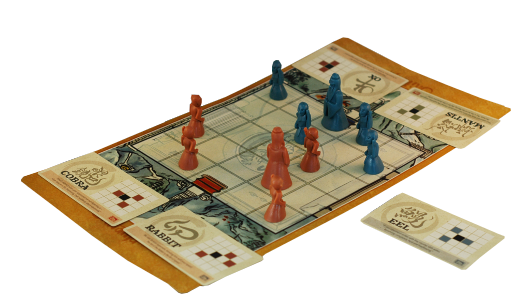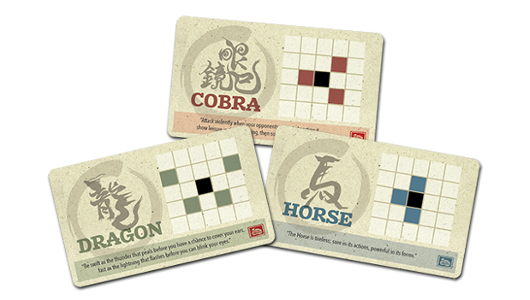Onitama carves an elegant niche out of one of the oldest and most densely occupied design spaces in board games: a two-player perfect information game. Its closest conceptual neighbours are legendary games like Chess, Checkers, Go, and Nine Men’s Morris, games that test classic skills: strategic look-ahead, reasoning from your opponent’s perspective, and evaluating strategic positions. So, it is a brave designer who ventures into the most explored space in gaming, having to find something new to add to this genre. Onitama succeeds in creating novelty within this ancient tradition by keeping it simple, and focusing our attention on its most innovative aspect: the move cards.
• Designer: Shimpei Sato
• Publisher: Arcane Wonders
• Number of Players: 2
• Playing Time: 15 minutes

The basic mechanics of Onitama are simple: each player gets five pawns placed on their side of a 5×5 grid. Five move cards are selected randomly from a deck of sixteen, each depicting a unique set of possible moves. The board allows you to move a pawn one square forward, or laterally to either adjacent square; the monkey can move one space diagonally in any direction; the tiger can move one space backwards or leap two spaces forwards; the dragon moves either diagonally backwards, or diagonally forward in an l-shape reminiscent of chess’ knight; and so on. The five moves are the only ones that will be played in the round. Players can move their pawns using the moves depicted on the cards. Each player possesses two cards at a time, with a floating card in the middle. When a player uses a card to make a move, they then swap it for the floating card. In this way, the cards cycle between the players, constantly changing the moves each player can make. Capturing pieces is as simple as moving your pieces on top of them, as in chess. The middle pawn in each player’s starting row is the master, and the space it begins on is the temple arch. The game is won when the opponent’s master is captured (the Way of the Stone), or when your master occupies your opponent’s temple arch (the Way of the Stream).

Having only five randomly drawn moves artfully avoids the most fundamental pitfall of the genre: the repetitive, deterministic nature of predictable moves against a fixed background. Even the mighty Chess suffers from a small series of plausible opening moves, which must be mastered before playing at an advanced level. By contrast, the relative geometry of the Onitama grid changes each game, because the cards change the meaning of the space. Each game is functionally different, with an abundance of possible combinations – 4,368 sets of moves, leading to (if I have done my maths correctly) 65,520 distinct opening states. This discourages memorisation, encourages fluid tactical thinking, and adds considerable replay value. It’s also a lot more fun for players who haven’t invested hundreds of hours of study. There will be no standard openings, no Morphy defence to the Ruy Lopez, and equally no fool’s mate; new players are not faced with a hopeless battle, so long as they can think on their feet.
The flow of cards from your side of the table is determined by your own moves, so even an apparently excellent play can come back to haunt you if it gives your opponent access to a key move two turns later. Board states can no longer be evaluated simply by looking at the positions of the pieces because the available moves are constantly shifting. It also makes each game strategically unique. In some games, moving diagonally will be available to both players on most turns, whereas, in others, it will be rare or even impossible. In others, moving leftwards will be much easier than moving rightwards, or backwards easier than forwards. Nevertheless, despite the fluidity introduced by the randomised cards, Onitama retains the clean, tactical determinism of the genre – there is no random element in play itself. The player who played better will always win, and the better player generally is the one who can think most deeply about movement and positioning.

Onitama has a classic martial arts theme, which is an excellent match for the fluid, tactical gameplay mechanics. The exchange of move cards feels very much like ritual combat, emphasising standardised forms, dynamic strategy, and using the opponent’s choices against them. The design is elegant, coloured in parchment tans offset by red and blue. The game maintains an archetypal setting, drawing heavily on well-worn martial arts tropes, but the touch is light enough that it feels appropriate. Each card has a clear description of its name (including some attractive calligraphy), the move it represents, and a tasteful piece of flavour text. The game also folds neatly into a smallish box for easy carrying, and its flexible play mat could be set up almost anywhere.
Overall, Onitama is a triumph of simplicity in design. It’s fun to play, easy to learn, and has enough depth to keep the attention of all but the most jaded players. Games take a breezy fifteen minutes, and most of this time is spent in analysis. I have not played enough to know if its tactical depth dries up after hundreds of games; likely it is not the next Chess or Go, but this is an unfair standard. Other attempts to explore this space (Vlaada Chvátil’s Tash-Kalar, for instance) have been dauntingly complex, whereas Onitama is refreshingly simple, maintaining the best features of the genre, and avoiding some of its worst traits. It would make an excellent introduction to tactical play for new players (or even children, the 14+ on the box seems excessively restrictive), without sacrificing the strategic depth necessary for advanced players.
Tags: Board Game, Dice Tower Essentials, Martial Arts, Shimpei Sato


